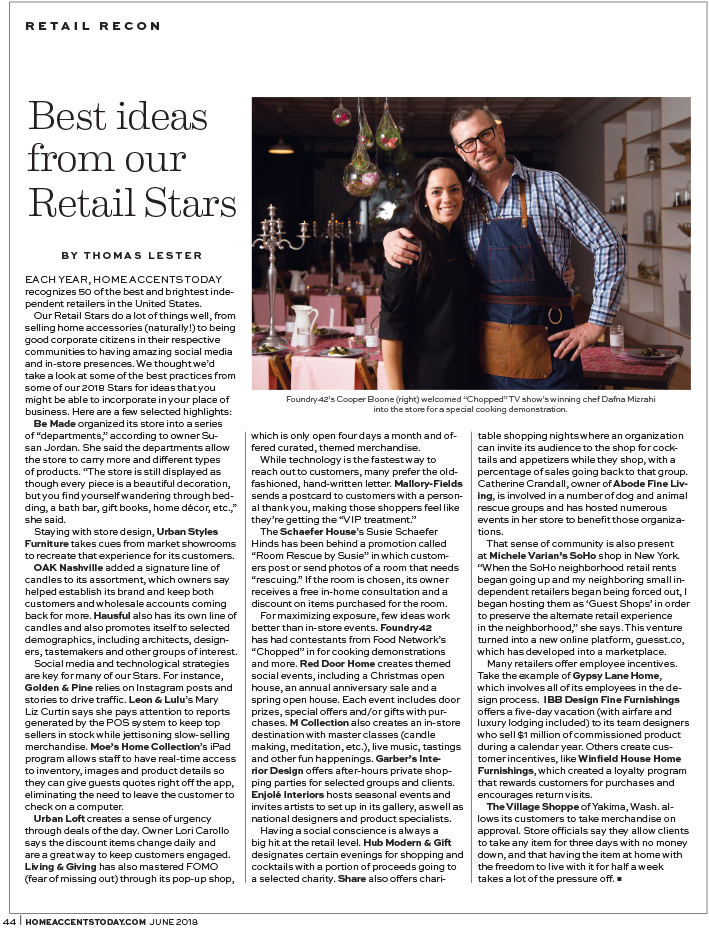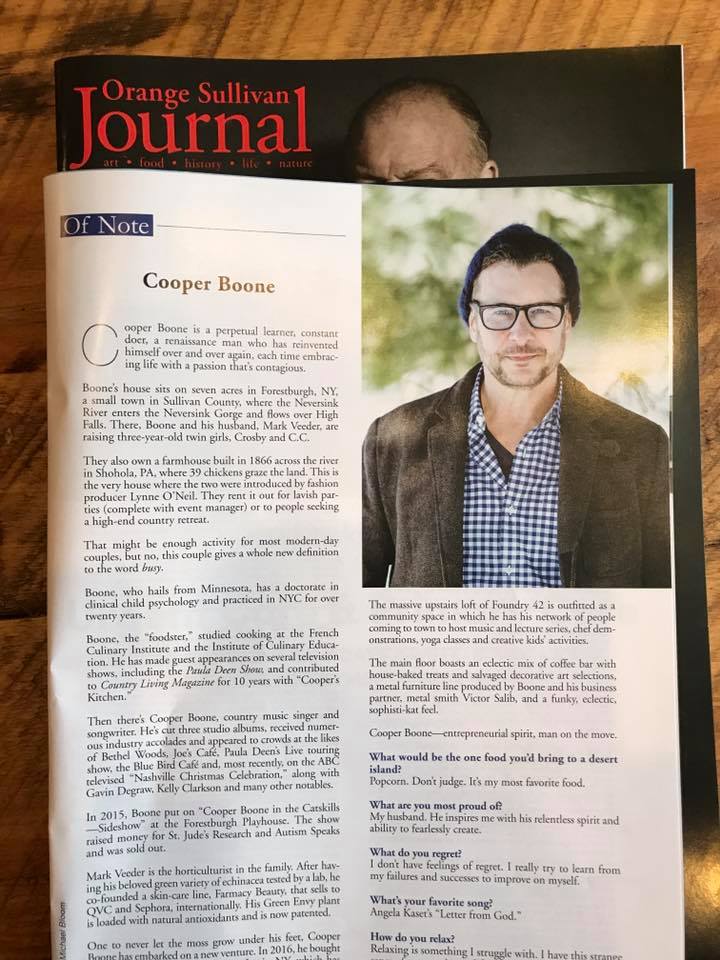Craft kits for children to make purses and rockets, a kid’s clothing line sown by a nearby seamstress, and a local skin care line made from plants.
From coffee to carbs, gifts and clothing, Foundry 42 is full of surprises, and the 2-year-old Port Jervis shop has got them whatever the size is.
It’s among the local stores reporting strong holiday sales revenue, with most shop owners expecting growth of around 5 percent this holiday season compared with last year.
Their preliminary predictions mirror the National Retail Federation’s rosy projection that sales revenues could reach $720.89 million for November and December, an increase of between 4.3 percent and 4.8 percent versus last year.
That would exceed the past five years’ 3.9 percent average annual increase, making 2018 among the best years since 2006, including 2010 (growth of 5.2 percent), 2014 (5 percent) and last year (5.3 percent), according to the National Retail Federation.
“Retail isn’t dead. Bad retail is dead,” said Foundry 42 owner Cooper Boone.
Buoying this year’s spending, unemployment is near a 50-year low, consumer confidence is at an 18-year high and wages are climbing, said Ted Potrikus, president of the Retail Council of New York, a trade association.
It’s too early to say for certain whether retailers will meet analysts’ projections, given the variability of weather, consumer fickleness and December’s incomplete figures, Potrikus said.
“But the National Retail Federation’s projections are realistic,” he added. “Somewhere in 3 (percent) to 6 percent range is a result we could see in mid-January” when sales totals are tallied.
With the calendar also providing four full weekends of shopping days between Thanksgiving and Christmas, “it’s been a particularly strong season,” said Michael Newhard, owner of Newhard’s general store in the Village of Warwick.
“We had our best day in 20 years this past Saturday (Dec. 15),” said Gary Holmes, owner of the Canal Towne Emporium in Wurtsboro, which sells gifts, clothing and 20 other categories of items. “We’ve had 15-person deep lines, at peak. It was just crazy. But there’s been no tension. Like Woodstock in ’69, it’s been crowded and busy, but with positive spirits and good moods.”
‘Cocooning,’ ‘hygge’ drive sales
Yet, more revenue hasn’t necessarily meant higher profits, as stores flatten prices and discount goods to compete with other shops and e-retailers, local store owners said.
Also devouring margins this year, retailers say, are higher costs for freight, fuel, utilities and labor, driven partly by state mandates, and expenses from tariffs from recent trade wars instigated by President Trump’s administration.
Stores “have to do more volume to increase profits, with better promotions and better discounts,” said Gary Gottlieb, co-owner of the Liberty Trading Post, a giant Sullivan County home goods, hardware and gift store. “We’ve been running aggressive ad campaigns with sharp prices ... and selling goods like Craftsman tools and Weber Grills at the lowest prices allowed” by the brands.
Locally and nationally, this year’s big sellers include housewares, practical home items like kitchen stuff, home bar equipment, small appliances, work tools, winter wear and holiday decorations.
Pine-scented candles and popcorn poppers are the top attractions at the Newburgh Mercantile Exchange gift store, said store co-owner Eric Jarmann.
“If shoppers are looking for something that’s unique and different, they’re going to the small shops,” Jarmann said.
The “cocooning,” wherein Americans more often relax and cook at home, is driving the popularity of home items, comfy clothes and utilitarian goods, according to the NPD Group, a retail research firm. Since the 2007 recession, Americans have been more interested in affordably creating a cozy home sanctuary.
The trend is an embrace of the Danish idea of “hygge” (pronounced “hue-guh”) or appreciating homespun pleasures, while alone or with friends, in casual, comfortable or lived-in spaces.
At Linda’s Office Supplies and Gifts in Goshen, customers come for items like a hand-painted Christmas ornament featuring Goshen Village Hall and clothes like pajamas.
Amid hyper-competition from online shopping options and a surplus of physical stores, the best shops give customers the most reasons to come, said Linda’s store owner Linda Mabie.
“People come for the service, presents wrapped for free, free parking in Goshen in December and our individual attention,” Mabie said.
Rich Gottlieb, co-owner of the New Paltz outdoors store Rock and Snow, agreed.
“We’ve always gone the extra mile for the customer,” said Gottlieb, whose staff gives tips for enjoying local attractions, picking appropriate recreational equipment and using it properly. “We find out who customers are and how they want to brand themselves. In many instances, they want to brand themselves not by what they wear but by what they do.”
Retail industry shakeout
Local store owners say such steps to differentiate themselves are critical given online retail competition.
Roughly eight in 10 Americans are now online shoppers, with one in six buying online on a weekly basis, according to a 2016 Pew Research Center study. All told, one in six dollars spent this holiday season is expected to come from online sales, according to Adobe Analytics, a research firm.
Just as challenging for the area’s retailers is the glut of brick-and-mortar stores. America’s 23.6 square feet of retail space per capita is nearly nine times Europe’s total, according to the International Council of Shopping Centers.
It’s no wonder nearly 7,000 U.S. store locations closed last year, a record, and almost 5,500 stores have shuttered this year through Nov. 16, according to Coresight Research.
Struggling retailers have been beset by overborrowing, fast-fashion powerhouses like H&M, online giants like Amazon, discounters like Marshalls and high costs from maintaining too many storefronts.
Malls, too, have suffered in recent years. After peaking at roughly 1,500 in the mid-1990s, malls now number approximately 1,000, a roughly 33 percent drop. Unique local stores and shop-local movements are luring people to seek gifts at stores like Newhard’s in Warwick, Newhard said.
“Main Street merchants offer a unique experience that’s hard to commercialize — places that look, sound and smell good, close-at-hand places where you can meet up with your neighbors and you’re not in your car for miles with screaming kids,” Newhard said.
Local retailers say they’re not just individualizing shopping experiences. They’re turning stores into experiential attractions, like Ikea, where shoppers lounge in comfy furniture and eat meatballs.
In Port Jervis, Foundry 42′s owner, Boone, expects his store’s holiday season revenues to soar 45 percent over last year’s totals, by appealing to customers as a gift and homewares store, a coffee shop and a venue for everything from art events to religious groups’ meetings.
“For me, retail is about bringing people together, being a conduit for people to enjoy good food, great music and beautiful things,” said Boone, who sends hand-written thank-you cards to big spenders. “Yes, internet sales are up, but the best retailers are providing a place for people to belong that makes people want to come back.”




















